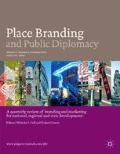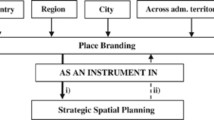Abstract
The shaping of a strong, recognizable and thus attractive identity of a place is closely linked to the process of effective planning, both on strategic and physical level. Heritage is a common branding tool that relied on the exploitation and presentation of, among others, urban forms related to the past. This research seeks to connect spatial strategies and place branding through the case study of the Region of Ruhr. The Ruhr Valley has long been linked to the industrial history of Europe due to the concentration of mining and steel industry. Today the region is undergoing a restructuring process. This work will focus on the strategies and actions implemented with an emphasis on the development of the Emscher Landshaftspark developed in the 1990s. The aim is to examine the gradual creation of a new identity through the sites’ transformation by identifying typological characteristics among the network’s flagship projects. Α key question is whether individual interventions compose a comprehensive and time-resistant branding strategy in conjunction with directions and practices of spatial planning formulating a distinctive model. The function of the main narrative as a framework of governance processes is going to be explored.

Source present authors

Source present authors

Source present authors

Source present authors
Similar content being viewed by others
Notes
For more information (access 20/02/20): http://www.route-industriekultur.ruhr/.
For more information (access 20/02/20): www.erih.net.
References
Andranovich, G., M. Burbank, and C. Heying. 2001. Olympic cities: Lessons learned from mega—Events. Politics. Journal of Urban Affairs 23 (2): 113–131.
Andres, L., and B. Grésillon. 2013. Cultural brownfields in European cities: A new mainstream object for cultural and urban policies. International Journal of Cultural Policy 19 (1): 40–62. https://doi.org/10.1080/10286632.2011.625416.
Asprogerakas, Evangelos. 2007. City competition and urban marketing: The case of tourism industry in Athens. TOURISMOS Journal 2 (1): 89–114.
Asprogerakas, Evangelos. 2016. Approaches of integrated urban interventions in Greece: Tools and governance elements. [Προσεγγίσεις ολοκληρωμένων αστικών παρεμβάσεων στην Ελλάδα: εργαλεία και στοιχεία διακυβέρνησης]. Aeihoros 26: 4–36.
Belabas, Warda, Jasper Eshuis, and Peter Scholten. 2020. Reimagining the city: Branding migration-related diversity. European Planning Studies. https://doi.org/10.1080/09654313.2019.1701290.
Belloso, Juan Carlos. 2011. The City branding of Barcelona: A success story. In City branding. Theory and cases, ed. K. Dinnie, 118–123. New York: Palgrave Macmillan.
Bianchini, F., and M. Parkin. 1993. Cultural policy and urban regeneration: The west European experience. Manchester: Manchester University Press.
Borja, J. 1996. Barcelona: An urban transformation model., Urban Management, Series 8 Quito: Urban Management Programme.
Bramwell, B., and L. Rawding. 1994. Tourism marketing organizations in industrial cities. Organizations, objectives and urban governance. Tourism Management 15 (6): 425–434.
CABE. 2006. Design task group report, strategic urban design/delivering place through design codes. https://webarchive.nationalarchives.gov.uk/20110118195833/http://www.cabe.org.uk/files/hmr11.pdf. Accessed 20 Mar 2020.
CABE. 2007. Design Task Group—Emscher Landscaftspark. http://webarchive.nationalarchives.gov.uk/20110118095356/http://www.cabe.org.uk/files/emscher.pdf. Accessed 20 Mar 2020.
Chang, Robin. 2018. Socio-economic resilience in the Ruhrgebiet, Faculty of Spatial Planning, Technical University Dortmund, interview in the framework of the programme “HeKriS 2017-19, 24.07.2018. Dortmund.
Cleave, Evan, Godwin Arku, Richard Sadler, and Jason Gilliland. 2016. The role of place branding in local and regional economic development: Bridging the gap between policy and practicality. Regional Studies, Regional Science 3 (1): 207–228. https://doi.org/10.1080/21681376.2016.1163506.
Couch, C., C. Fraser, and S. Percy. 2003. Urban regeneration in Europe. Oxford: Blackwell Science.
Cox, Wendell. 2013. The evolving urban form: the Rhine-Ruhr. http://www.newgeography.com/content/003769-the-evolving-urban-form-the-rhine-ruhr-essen-d-sseldorf. Accessed 1 Mar 2020.
Danielzyk, R., and G. Wood. 1993. Restructuring old industrial and inner urban areas: A contrastive analysis of state policies in Great Britain and Germany. European Planning Studies 1 (2): 123–147.
Danielzyk, R., and G. Wood. 2004. Innovative strategies of political regionalisation: The case of North Rhine-Westphalia. European Planning Studies 12 (2): 191–207.
Deffner, A., and L. Labrianidis. 2005. Planning culture and time in a mega-event: Thessaloniki as the European city of culture in 1997. International Planning Studies 10: 241–264.
Deffner, A., and C. Liouris. 2005. City marketing: A significant planning tool for urban development in a globalised economy. Paper presented at the 45th Congress of the European Regional Science Association, 23–27 August, Amsterdam.
Deffner, Alex, Karachalis Nicholas, Psatha Eva, Metaxas Theodore, and Sirakoulis Kleanthis. 2019. City marketing and planning in two Greek cities: Plurality or constraints? European Planning Studies. https://doi.org/10.1080/09654313.2019.1701291.
Dinnie, K. 2011. City branding. Theory and cases. New York: Palgrave Macmillan.
Dorsey, J.W. 2003. Brownfields and Greenfields: The intersection of sustainable development and environmental stewardship. Environmental Practice 5 (1): 69–76. https://doi.org/10.1017/s1466046603030187.
Eckardt, Frank. 2017. Architecture and the “Right to the City”: The IBA Hamburg as a case for critical urban studies. In Architecture and the social sciences, ed. Mendes Maria Manuela, Sá Teresa, and Cabral João. Berlin: Springer. https://doi.org/10.1007/978-3-319-53477-0.
Freundt, A. 2002. Culture industries in old industrialized regions: A successful strategy for innovative regional development?. Dortmund: ERSA Congress.
Getz, D. 1991. Festivals, special events, and tourism. New York: Van Nostrand Reinhold.
Goch, S. 2002. Betterment without Airs: Social, cultural, and political consequences of de-industrialization in the Ruhr. In IRSH 47. pp. 87–111. Internationaal Instituut voor Sociale Geschiedenis. https://doi.org/10.1017/s0020859002000792.
Goess, S., M. Jong, and E. Meijers. 2016. City branding in polycentric urban regions: Identification, profiling and transformation in the Randstad and Rhine-Ruhr. European Planning Studies 24 (11): 2036–2056. https://doi.org/10.1080/09654313.2016.1228n.
Grenni, S., L.G. Horlings, and K. Soini. 2019. Linking spatial planning and place branding strategies through cultural narratives in places. European Planning Studies. https://doi.org/10.1080/09654313.2019.1701292.
Griffiths, R. 1995. Cultural strategies and new modes of urban intervention. Cities 12 (4): 253–265.
Hall, C.M. 1997. Hallmark tourist events: Impacts, management and planning. Chicester: Wiley.
Hankinson, G. 2010. Place branding theory: A cross—Domain literature review from a marketing perspective. In Towards effective place brand management. Branding European cities and regions, ed. G. Ashworth and M. Kavaratzis, 15–35. Cheltenham: Edward Elgar.
Jago, L., and R. Shaw. 1998. Special events: A conceptual and differential framework. Festival Management and Event Tourism 5: 21–32.
Kavaratzis, M. 2008. From city marketing to city branding: An interdisciplinary analysis with reference to Amsterdam, Budapest and Athens, PhD Thesis, University of Groningen.
Keil, Α., and B. Wetterau. 2012. Metropolis Ruhr. A regional study of the new Ruhr. Essen: Regionalverband Ruhr, Department for Strategic Development and Communication, Woeste Druck + Verlag.
Knapp, W., K.R. Kunzmann, and P. Schmitt. 2004. A co-operative spatial future for RheinRuhr. European Planning Studies 12: 323–334.
Kunzmann, K. 2004. Creative brownfield redevelopment: The Experience of the IBA Emscher park initiative in the Ruhr in Germany. In Recycling the city: The use and reuse of urban land, ed. Rosalind Greenstein and Yesim Sungu-Eryilmaz, 201–217. Cambridge: Lincoln Institute of Land Policy.
Kunzmann, R. 2013. Ruhrgebietslied. In From urban systems to sustainable competitive metropolitan regions. Essays in honor of Leo van den Berg, ed. Meine Pieter van Dijk, Jan van der Meer, and Jan van der Borg, 71–91. Rotterdam: Erasmus University.
Kyvelou, S. 2010. From spatial planning to spatial management: the concept of strategic spatial planning and territorial cohesion in Europe. [Από τη χωροταξία στη χωροδιαχείριση]. Athens: Kritiki Publications. ISBN: 9789602186718.
Lucarelli, Andrea, and Cassel Susanna. 2019. The dialogical relationship between spatial planning and place branding: Conceptualizing regionalization discourses in Sweden. European Planning Studies. https://doi.org/10.1080/09654313.2019.1701293.
Paddison, R. 1993. City marketing, image reconstruction and urban regeneration. Urban Studies 30 (2): 339–350.
Pasquinelli, Cecilia, and Jukka Teräs. 2013. Branding knowledge-intensive regions: A comparative study of Pisa and Oulu high-tech brands. European Planning Studies 21 (10): 1611–1629. https://doi.org/10.1080/09654313.2012.722962.
Pinch, Philip, and Adams Neil. 2013. The German Internationale Bauausstellung (IBA) and Urban Regeneration. In The Routledge Companion to Urban Regeneration, eds. Michael E. Leary, and John McCarthy, 230–241. Routledge. https://doi.org/10.4324/9780203108581.ch19.
San Eugenio-Vela, Jordi, Xavier Ginesta, and Mihalis Kavaratzis. 2019. The critical role of stakeholder engagement in a place branding strategy: A case study of the Empordà brand. European Planning Studies. https://doi.org/10.1080/09654313.2019.1701294.
Schwarze-Rodrian, Michael. 2018. Regionalverband Ruhrgebiet, Director, Regionalverband Ruhr, presentation and interview in the framework of the programme “HeKriS 2017-19. 25.07.2018. Essen.
Serraos, K, and E. Asprogerakas. 2012. Urban planning and place branding. Searching for effective urban development tools in Greece during the economic crisis, [« Σχεδιασμός και ταυτότητα του τόπου. Αναζήτηση αποτελεσματικών εργαλείων αστικής ανάπτυξης στην Ελλάδα της οικονομικής κρίσης »]. In Δέφνερ Α., & Καραχάλης Ν., (επιμ.) Marketing και Branding Τόπου, Η Διεθνής Εμπειρία και η Ελληνική Πραγματικότητα (σελ. 57–81), Πανεπιστημιακές Εκδόσεις Θεσσαλίας, (ISBN: 960-9439-14-4).
Serraos, K, E. Asprogerakas, and P. Voulelis. 2017. Spatial governance and city branding: Germany’s experience in participatory processes for planning and development, [Χωρική Διακυβέρνηση και Διαμόρφωση της Ταυτότητας της Πόλης: Η Εμπειρία της Γερμανίας στις Συμμετοχικές Διαδικασίες για το Σχεδιασμό και την Ανάπτυξη], in 2ο Πανελλήνιο Συνέδριο Marketing και Branding του Τόπου, (Πρακτικά Συνεδρίου) Τμήμα Μηχανικών Χωροταξίας, Πολεοδομίας και Περιφερειακής Ανάπτυξης Πανεπιστημίου Θεσσαλίας, Δ. Λαρισαίων, 31/03-02/04.
Shaw, R. 2002. The International Building Exhibition (IBA) Emscher Park, Germany: A model for sustainable restructuring? European Planning Studies. 10 (1): 77–97. https://doi.org/10.1080/09654310120099272.
Smyth, Hedley. 2005. Marketing the city. The role of flagship developments in urban regeneration (first edition 1994). London: E & FN Spon.
Sousa, D.E.C. 2004. The greening of Brownfields in American cities. Journal of Environmental Planning and Management 47 (4): 579–600.
Van Assche, Kristof, Raoul Beunen, and Oliveira Eduardo. 2019a. Spatial planning and place branding: Rethinking relations and synergies. European Planning Studies. https://doi.org/10.1080/09654313.2019.1701289.
Van Assche, Kristof, Raoul Beunen, and Oliveira Eduardo. 2019b. Rethinking planning-branding relations: An introduction. European Planning Studies. https://doi.org/10.1080/09654313.2019.1701288.
Ward, S. 1998. Selling places. The marketing and promotion of towns and cities 1850-2000. London: E&FN Spon.
Wassenhoven L., K. Sapountzaki, E. Asprogerakas, H. Gianniris H., and Th. Pagonis. 2010. Spatial governance: Theory, European experience and the case of Greece, [« Χωρική. Διακυβέρνηση – Θεωρία, Ευρωπαϊκή Εμπειρία και η Περίπτωση της Ελλάδας »], 352 (in Greek). Athens: Kritiki Publications. ISBN: 9789602187197.
Zimmermann, Karsten. 2018. Socio-economic Resilience in the Ruhrgebiet. Faculty of Spatial Planning, Technical University Dortmund, interview in the framework of the programme “HeKriS 2017-19, 11.09.2018. Dortmund.
Acknowledgements
The authors would like to thank the two reviewers for their efforts.
Funding
Funding was provided by Deutscher Akademischer Austauschdienst (HeKriS 2017-19: Herausforderung Krisenfestigkeit europäischer Städte: Entwicklung planerischer Strategien und kreativer Maßnahmen durch die ochschulkooperation von NTUA und LUH).
Author information
Authors and Affiliations
Corresponding author
Ethics declarations
Conflict of interest
On behalf of all authors, the corresponding author states that there is no conflict of interest.
Additional information
Publisher's Note
Springer Nature remains neutral with regard to jurisdictional claims in published maps and institutional affiliations.
Rights and permissions
About this article
Cite this article
Asprogerakas, E., Mountanea, K. Spatial strategies as a place branding tool in the region of Ruhr. Place Brand Public Dipl 16, 336–347 (2020). https://doi.org/10.1057/s41254-020-00168-1
Revised:
Published:
Issue Date:
DOI: https://doi.org/10.1057/s41254-020-00168-1




